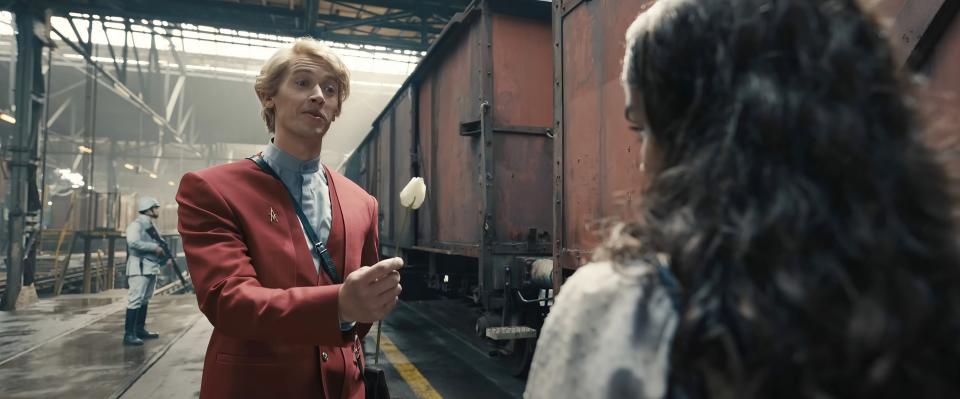Without Sets, ‘The Hunger Games’ Prequel Grabbed the Chance for a Fresh Look

- Oops!Something went wrong.Please try again later.
Director Francis Lawrence first came to the “Hunger Games” franchise in 2013 for “The Hunger Games: Catching Fire,” and he’s helmed every movie in the series since. His latest entry is “The Hunger Games: The Ballad of Songbirds and Snakes,” the fifth film in the franchise and Lawrence’s fourth. Set over 60 years before the events of the first film, “Songbirds and Snakes” retains the spirit of the earlier movies while crafting its own aesthetic. As Lawrence told IndieWire’s Filmmaker Toolkit podcast, its prequel status meant he wasn’t beholden to anything previously established in the series.
“I think that gave us the freedom to take it in a very different direction aesthetically,” Lawrence said. “It’s, in essence, a period piece.” Lawrence and his department heads took their cues from reconstruction-era Berlin for the visual design, which is given an added layer of verisimilitude by the fact that there are virtually no sets — everything was shot on location in Poland and Germany. “It’s always important to me to have as many real places as possible so that it’s immersive for the actors.” The key for Lawrence was showcasing those locations while keeping close to the actors, putting the characters in the context of their surroundings and in relation to each other; to do so, he continued developing an approach that began on his first “Hunger Games” movie.
More from IndieWire
Chris Columbus Teases a 'Mrs. Doubtfire' Documentary: 'We Want to Show Robin's Process' of Improv
How J.A. Bayona's Uruguayan Plane Crash Drama 'Society of the Snow' Honors the Dead
“Working with the fantastic actors in these movies has taught me to think a little less visually and a little more like an actor,” Lawrence said. “I’m not putting shots first, I’m trying to focus on what feels believable and natural and interesting and serves the emotional value of the scene.” Rather than move the actors for the sake of a visual, Lawrence designs the shots around how the characters would naturally behave and move, utilizing wide-angle lenses that keep them situated in their environment. “I like an audience to feel intimate with the actors, and when you use wide-angle lenses you maintain a sense of geography and scale as opposed to a long lens that compresses everything and throws everything out of focus to isolate a character. The environment vanishes, and I feel that, subconsciously, audiences feel the distance.”
Although “Catching Fire” was captured on film, every subsequent “Hunger Games” movie was shot in a digital format with a steady evolution in Lawrence and cinematographer Jo Willems’ approach. The major development for Lawrence came after shooting on a large format Alexa while directing Apple TV+’s series “See.” “We started using the 65mm sensor, and I fell in love with how different the depth of field is and how the lenses for that camera go much wider without warping people’s faces,” Lawrence said. “You really get that intimacy and maintain scope at the same time.” Lawrence and Willems shot “Songbirds and Snakes” on an Alexa LF mini, which allowed them to capture that juxtaposition of the intimate and the epic more effectively than ever. “You can bring the cameras much closer to people without worrying about their noses getting too big and all of that,” Lawrence said. “And there’s a textural quality that comes with the depth of field.”

Even after four “Hunger Games” movies, Lawrence hasn’t lost his appetite for the series — he’s just waiting for novelist Suzanne Collins to write more books. “I know Nina [Jacobson, the movie’s producer] and I don’t want to develop anything without her,” Lawrence said. “If there’s another ‘Hunger Games’ movie, it’s up to Suzanne. If she writes another book, then I’m in.”
Best of IndieWire
The Best Animated Series of All Time: 'Daria,' 'Cowboy Bebop,' 'Scott Pilgrim Takes Off,' and More
The 62 Best Animated Movies of the 21st Century, from 'Marcel the Shell' to 'The Boy and the Heron'
Where to Watch This Week's New Movies, from 'Napoleon' and 'Saltburn' to 'Maestro'
Sign up for Indiewire's Newsletter. For the latest news, follow us on Facebook, Twitter, and Instagram.

